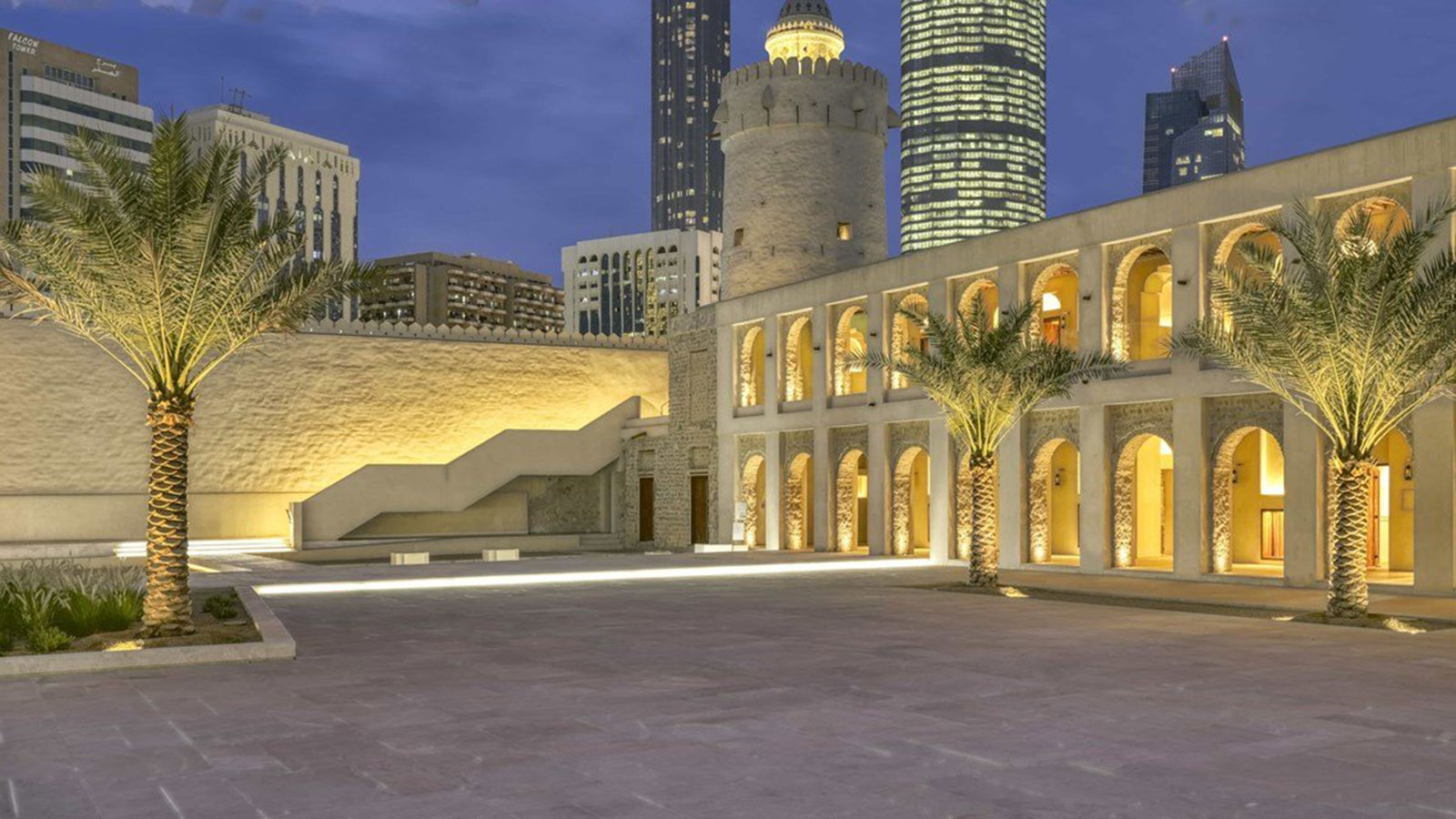Al Hosn, Abu Dhabi is a historical landmark significant in the city’s history. It is the oldest stone structure in Abu Dhabi, known as Qasr Al Hosn. The structure was built in 1761 and was designed by Mohammed Al Bastaki. It served as the ruling family’s residence and later became the seat of government.
Today, Al Hosn in Abu Dhabi is a popular tourist destination that draws people from all over the world. It has been restored and renovated to preserve its historical significance and to provide visitors with an insight into the city’s rich cultural heritage. The site comprises two major iconic buildings: the Inner Fort and the Outer Palace. Visitors are able to visit the different attractions that showcase the history and culture of Abu Dhabi, including traditional crafts, clothing, and artifacts.
Some of the key features of Al Hosn, Abu Dhabi, that visitors can explore include the following:
- The House of Artisans celebrates the UAE’s rich intangible heritage and showcases the history of traditional Emirati crafts through an imaginative exhibition.
- The watchtower was the city’s first permanent structure and overlooked the coastal trade routes.
- The commanding structure of the Inner Fort served as the residence of the ruling family and later became the seat of government.
- The Outer Palace was built in the 1940s and served as the ruling family’s residence until the 1960s.
- The various exhibits and displays that showcase the history and culture of Abu Dhabi, including traditional crafts, clothing, and artifacts.
History of Al Hosn
Early Beginnings
Al Hosn, also known as Qasr Al Hosn, is the oldest stone building in Abu Dhabi and holds a significant place in the history of the United Arab Emirates (UAE). The fort was built in 1761 by Sheikh Shakhbut bin Dhiyab as a watchtower to protect the growing settlement established on the island. It was strategically positioned to overlook the coastal trade routes and was a focal point for the community.
Role in UAE Formation
Al Hosn played a crucial role in forming the UAE. It was the ruling family’s residence and served as a center for political and social activities. The fort also housed important government offices, including the police station and the post office. In 1966, the fort was converted into a museum to preserve and showcase the history and culture of Abu Dhabi.
Renovation and Preservation
In order to preserve its historical significance, Al Hosn has undergone a number of renovations and preservation projects over the years. In 2018, the fort underwent a major renovation to restore its original features and improve its accessibility to visitors. The renovation included the restoration of the historic watchtower and adding a visitor center, exhibition spaces, and a library.
Al Hosn symbolizes the rich history and culture of Abu Dhabi and the UAE. Its preservation and restoration efforts have helped to maintain its historical significance and ensure that future generations can appreciate its importance.
Architecture and Structure
Inner Fort
The Inner Fort, also known as the White Fort, is a significant part of the Al Hosn complex. It is the oldest building in Abu Dhabi and was built in 1793 as a watchtower to protect the city’s only freshwater well. The fort was later expanded to include a palace and other buildings. The architecture of the Inner Fort is a blend of traditional Arab and Persian styles, with thick walls and small windows to keep the interior cool in the hot desert climate. The fort’s interior includes a courtyard, living quarters, and storage areas.
Outer Palace
The Outer Palace is another important building in the Al Hosn complex. It was built in the 1940s to serve as a place of worship for the Abu Dhabi royal family. The palace’s architecture combines traditional Arab and modern styles, with large windows and balconies overlooking the city. The palace’s interior includes reception rooms, living quarters, and a grand hall.
Defensive Features
The Al Hosn complex was designed with several defensive features to protect against attacks. The Inner Fort’s thick walls and small windows were a natural defense against invaders. The complex also includes a series of towers and gates to control access to the palace. The watchtower in the Inner Fort was used to monitor the surrounding area and alert the palace of potential threats.
Overall, the Al Hosn complex is a remarkable example of traditional Arabian architecture and design. Its distinctive combination of contemporary and traditional architecture, strategic location, and defensive features make it an important landmark in Abu Dhabi’s history.
Cultural Significance
Al Hosn, Abu Dhabi is a place of great cultural significance. It has played a vital role in the region’s cultural heritage and continues to do so today. The following subsections explore some key aspects of Al Hosn’s cultural significance.
House of Artisans
The House of Artisans is a cultural center in Al Hosn. It is committed to safeguarding traditional arts and techniques and promoting the work of local artisans. Visitors can learn about the history of crafts in the region and see demonstrations of traditional techniques such as weaving, pottery, and metalworking. The House of Artisans is an important part of Al Hosn’s cultural heritage and a must-visit destination for anyone interested in traditional crafts.
National Consultative Council
The National Consultative Council is a legislative body that was established in 1992. It is responsible for advising the ruling family on matters of national importance and promoting cultural and social development in the region. The Council is an important part of Al Hosn’s cultural heritage and has played a key role in shaping the region’s cultural and political landscape.
Cultural Foundation
The Cultural Foundation is a non-profit organization that was established in 1981. It is dedicated to promoting the arts and culture of the region and supporting local artists and cultural institutions. The Foundation is an important part of Al Hosn’s cultural heritage and has played a key role in preserving and promoting the region’s rich cultural traditions.
In conclusion, Al Hosn, Abu Dhabi is a place of great cultural significance. Its House of Artisans, National Consultative Council, and Cultural Foundation are just a few examples of the many cultural institutions that make Al Hosn an important part of the region’s cultural heritage. Visitors to Al Hosn can learn about the region’s rich cultural traditions and experience the vibrant culture that continues to thrive in the region today.
Museum and Exhibits
Permanent Collections
The museum exhibits at Al Hosn in Abu Dhabi are designed to take visitors on a journey through the rich history of the UAE. The permanent collections are housed in the Inner Fort and showcase a range of artifacts and weapons that have played a significant role in the region’s development.
Visitors can expect diverse items, including traditional Emirati clothing, jewelry, and weaponry. There are also archival materials that offer insight into the lives of the people who lived and worked in the fort over the centuries.
Temporary Exhibitions
Al Hosn hosts a range of temporary exhibitions every year in addition to its permanent collections. These exhibits showcase different aspects of Emirati culture and history and offer visitors a deeper understanding of the region’s unique heritage.
Past temporary exhibitions have included displays of contemporary Emirati art and exhibitions exploring the region’s maritime history and relationship with the sea.
All things considered, the Al Hosn Museum’s displays provide an engrossing look into the past and culture of the United Arab Emirates. Whether visitors are interested in traditional Emirati crafts, archival materials, or contemporary art, there is something for everyone to enjoy.
Cultural Events and Activities
Al Hosn Festival
Al Hosn Festival is an annual cultural event that celebrates the rich heritage of Abu Dhabi. The festival is held at the Al Hosn site, which is home to the iconic Qasr Al Hosn historic site. The festival features various activities and performances that showcase the Emirate’s traditional and contemporary culture. Visitors can enjoy a variety of demonstrations, workshops, and public events that highlight the different components of Emirati heritage.
Educational Workshops
The Al Hosn Festival offers educational workshops that allow visitors to learn about the Emirate’s culture and history. Experts lead these workshops in the field and cover various topics, including traditional crafts, music, and dance. Visitors are able to engage in hands-on activities and understand the techniques and materials used in traditional Emirati crafts.
Live Performances
The Al Hosn Festival features live music and dance performances that showcase the Emirate’s traditional and contemporary culture. Visitors are able to witness performances by international and local artists, including traditional performances and contemporary interpretations of Emirati culture. The festival also features dance performances highlighting Emirati dance’s different styles and techniques.
The festival is a must-visit for anyone interested in learning about the culture and history of Abu Dhabi. Visitors can enjoy various activities and performances that showcase the Emirate’s rich heritage, including traditional crafts, music, and dance. The festival provides a rare chance to get to know Emirati culture’s different components and become part of its ever-evolving possibility.
Artisan Crafts and Heritage
The House of Artisans at Al Hosn in Abu Dhabi is a center that promotes the preservation of the UAE’s rich heritage and crafts created from the Emirati culture. The center gives Emirati craftspeople a place to work and teach the next generation of craftspeople. Here are some of the artisan crafts and heritage that are showcased at the House of Artisans:
Khoos and Talli
Talli and Khoos are traditional Emirati crafts showcased at the House of Artisans. Talli is a type of embroidery used to decorate clothing, while Khoos is a type of weaving used to make baskets and mats. Visitors can learn about the history and techniques of these crafts and watch demonstrations by skilled artisans.
Sadu Weaving
Bedouin women in the United Arab Emirates engage in a traditional weaving craft called al-sad. Women craft stunning and unique designs rich in geometric patterns from the wool of sheep, camels, and goats. These designs frequently represent social identity and the surrounding environment. The House of Artisans showcases the history and techniques of this ancient craft and the various items that can be made using Al-Sadu weaving.
Intangible Cultural Heritage
The House of Artisans also celebrates the intangible cultural heritage of the UAE, which includes customs, traditions, and practices passed down from generation to generation. Visitors are able to gain an understanding of the intangible cultural heritage, such as the importance of hospitality, the traditional Emirati diet, and the significance of falconry in Emirati culture.
In conclusion, the House of Artisans at Al Hosn in Abu Dhabi is a must-visit destination for anyone interested in learning about Emirati crafts and heritage. Visitors can explore the various exhibits and demonstrations and purchase handmade crafts and souvenirs from the gift shop.
Visitor Information
Location and Accessibility
Al Hosn is located in the heart of Abu Dhabi, between Zayed the First Street and Khalifa bin Zayed Street. Visitors can easily access the site by bus or taxi. If using public transportation, visitors can take bus number 007, which stops at Al Hosn. Taxis are also easily accessible and can drop visitors off at the site’s entrance. A map of the area is available on the Al Hosn website.
Opening Hours and Tickets
Al Hosn welcomes guests from 10:00 am to 8:00 pm on Fridays and Saturdays and from 9:00 am to 7:00 pm on Sunday through Thursday. Tickets can be purchased online or at the site’s entrance. Admission for adults is AED 30, while children under six can enter for free. Discounted tickets are available for students and seniors.
Nearby Attractions
Visitors can explore several nearby attractions while visiting Al Hosn. These include:
- The Abu Dhabi Falcon Hospital, where visitors can learn about falconry and see these majestic birds up close.
- The Sheikh Zayed Grand Mosque, one of the largest mosques in the world and a stunning example of Islamic architecture.
- The Emirates Palace, a luxurious hotel that offers tours of its grounds and amenities.
Visitors can also explore the nearby shopping and dining options, including the Abu Dhabi Mall and the Marina Mall.
Frequently Asked Questions
What are the historical uses of Qasr Al Hosn?
- Qasr Al Hosn was built as a watchtower in the 18th century to protect the city’s only freshwater well.
- Later, it served as the residence of the ruling family and the seat of government.
How can one purchase tickets for Qasr Al Hosn, and is there an entrance fee?
- Tickets for Qasr Al Hosn can be purchased online or at the ticket counter.
- There is an entrance fee, but it varies depending on the ticket type and the visitor’s age.
What are the unique features of Qasr Al Hosn that distinguish it from other landmarks?
- Qasr Al Hosn is the oldest and most significant building in Abu Dhabi.
- It has undergone several renovations, preserving its historical and cultural significance.
- It features a blend of traditional and modern architecture.
Who were the historical residents of Qasr Al Hosn?
- Qasr Al Hosn was the residence of the ruling family of Abu Dhabi.
- It was also the seat of government, and many important decisions were made within its walls.
How does the Al Hosn app enhance the visitor experience?
- The Al Hosn app provides visitors with an interactive map, audio guides, and other features that enhance the visitor experience.
- It also allows visitors to purchase tickets and make reservations in advance.
What are the current entry requirements for visitors to Al Hosn?
- Visitors are required to present a valid ID or passport to enter Al Hosn.
- They must also follow the dress code and other rules and regulations the management sets.
Abu-Dhabi MLS
For professionals in the real estate field, Abu-Dhabi MLS is an essential tool, delivering a complete guide to navigating thriving brokerages, forming crucial connections with potential clients, and widening their proficient network. The platform displays a variety of opportunities. Immerse yourself in its array of services while you carve your path to success by affiliating with Abu-Dhabi MLS.












